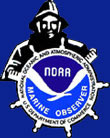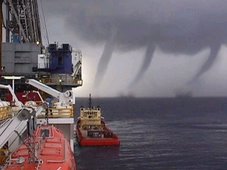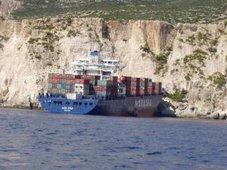NOAA SATELLITES READY FOR ACTIVE HURRICANE SEASON
 June 18, 2007 — With an active Atlantic hurricane season expected for 2007, NOAA’s high-powered satellites are ready to send forecasters a steady stream of crisp, detailed images, and other important data, of any storm that develops in the Western Hemisphere.
June 18, 2007 — With an active Atlantic hurricane season expected for 2007, NOAA’s high-powered satellites are ready to send forecasters a steady stream of crisp, detailed images, and other important data, of any storm that develops in the Western Hemisphere.
The NOAA Satellite and Information Service operates a fleet of spacecraft that monitor the weather, including conditions that trigger hurricanes and the tornadoes and floods that accompany them. “These satellites often provide us with the first indication that a storm is forming and they play an important role in predicting where a storm will go,” said Mary Kicza, assistant administrator for NESDIS.
NOAA’s Geostationary Operational Environmental Satellites (GOES), which operate from a fixed position 22,500 miles above the east and west coasts, take constant images of hurricanes and track their movement. Additionally, NOAA’s Polar-orbiting Operational Environmental Satellites (POES), which operate 530 miles over the Earth, orbiting the entire planet, keep an eye on storms, while providing data — including sea-surface temperatures, which is incorporated into global weather models.
Satellite data is used in combination with hurricane buoys, hurricane hunter aircraft, air-borne Doppler radar, dropwindsondes, and the experience and skill of NOAA’s forecasters to predict tropical storm impacts.
“Our satellites are in good health and are closely watching the oceans for any hint of tropical storm activity,” Kicza added. “Our top priority is to provide the satellite images and data to NOAA meteorologists, who make the forecasts that enable emergency managers to help people get out of harm’s way.”
NOAA Satellite Fleet
NOAA currently has four geostationary spacecraft: two are in operation, one is stored in orbit as a ready backup and one satellite currently used to provide better coverage of South America as part of the World Meteorological Organization’s World Weather Watch Global Observing System. GOES are the nation’s primary hurricane spotters from space.
NOAA also has five polar-orbiting satellites – two that are operational, including a spacecraft in a joint venture with Europe, with three more serving as backup satellites. POES are key in monitoring changes in the atmosphere and ocean temperatures and climate phenomena, such as El Niño and La Niña.
“We have an elaborate system in place, including back-up satellites and partnerships with other nations, that would handle any hiccups and keep monitoring storms,” said Kathy Kelly, director of the NOAA Satellite Operations and Satellite Data Processing and Distribution.
Additionally, NESDIS processes data from other spacecraft, such as NASA’s research QuikSCAT satellite, which is used in hurricane forecast models. “Our forecasters are using research tools like QuickSCAT to develop enhanced forecast models,” said Mary Glackin, acting director of the NOAA National Weather Service. “NOAA’s satellites are a key component to accurate hurricane forecasts, but our focus on next-generation technologies will ensure continued to improvement in hurricane services.”
Just last week, NOAA officially dedicated a new home for its around-the-clock environmental satellite operations. The NOAA Satellite Operations Facility, in Suitland, Md., supports a range of high-technology equipment, including 16 antennas that control more than $4.7 billion worth of environmental satellites. Each day, NSOF processes more than 16 billion bytes of environmental data from NOAA’s satellites and the Department of Defense’s Meteorological Satellite Program.
 NOAA Satellites Show Moxie
NOAA Satellites Show Moxie
During the 2005 Atlantic hurricane season, when a record 28 storms developed, NOAA satellites sent a total of 11,736 images of these cyclones to forecasters at the NOAA National Hurricane Center in Miami, Fla. In the relatively quiet 2006 hurricane season, the number of images was 7,380. (Click NOAA image for a larger view of Hurricane Katrina on Aug. 28, 2005, at 9:15 a.m. EDT - Category 5 strength. Also shown is the NOAA GOES-12 satellite, which monitors Atlantic hurricanes. Click here for high resolution version. Please credit “NOAA.”)
In New Orleans, ground zero for Hurricane Katrina, the costliest hurricane in U.S. history, GOES sent 716 images of the storm between August 26 and August 30.
“During Katrina, nothing could have been more helpful to forecasters than [NOAA] GOES imagery,” said Paul Trotter, meteorologist in charge of the NOAA National Weather Service forecast office in Slidell, La. “In areas where observations were limited, satellite imagery of the southwest movement of Katrina, once it began to move through and exit Florida, gave tremendous lead time of the eventual curve toward southeast Louisiana.”
Future NOAA Satellites
NOAA and NASA are planning the next generation of satellites that will strengthen the prediction and tracking of hurricanes. Known as the GOES-R series, these next generation satellites are expected to bring key improvements in data for predicting severe weather, including hurricanes. GOES-R data will result in longer watch and warning lead times and a better definition of the threat area for hurricanes and other dangerous weather.
“Since the first GOES satellite began monitoring the weather in 1975, we have never stopped trying to make this system better,” Kicza said.
Also planned for the future is the National Polar-orbiting Operational Environmental Satellite System, or NPOESS. This satellite system also will bring improved data and imagery for better weather forecasts, severe-weather monitoring and detection of climate change.
Relevant Web Sites
NOAA Satellite and Information Service


































































































![Validate my RSS feed [Valid RSS]](valid-rss.png)